Every morning in Africa, a gazelle wakes up. It knows it must run faster than the fastest lion, or it will be killed. Every morning a lion wakes up. It knows it must outrun the slowest gazelle, or it will starve to death. It doesn’t matter whether you are a lion or a gazelle. When the sun comes up, you better start running.
– African proverb
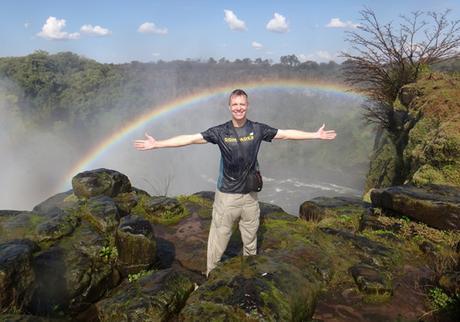
Every marathon hangs on a moment of truth. That defining instant when you realize the outcome of your race hinges on what happens next. Never sure when it will arrive, you know it when it does. At that crucial moment, will you blink first? Or will you hold your ground, dig deep and find a way to maintain focus, to tune out the dissonant voices in your head, to will yourself through the fatigue and discomfort and across the finish?
I hate to blink first. Most athletes do. Yet sometimes it’s a necessary evil, a survival skill—and this time I was eager to do so. Because never before had my moment of truth blinked back…
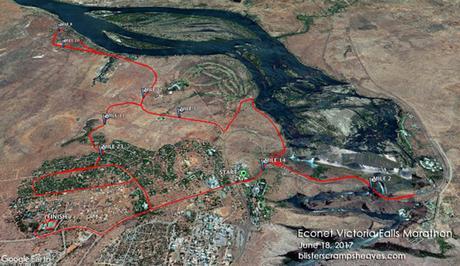
I have no idea what to expect, I realized as I cycled through my pre-race warmup absent-mindedly in a last-minute attempt to awaken my dormant legs.
Since crossing the Comrades Marathon finish line in Pietermaritzburg, South Africa two weeks earlier—hands-down the highlight of my running career to date—I hadn’t run a single step. Walked plenty, run none. We’d spent the past two weeks playing tourist first in South Africa and now in Zimbabwe, and understandably I’d had little time or interest in reacclimating my legs to running. They’d earned the rest.
Besides, runners typically “taper” before a big race. For a standard 12- to 16-week training cycle, this means that starting four weeks before race day when training mileage is at its peak, a runner will reduce their mileage gradually over the next three weeks culminating in race day. The purpose of the taper is to strike a delicate balance that ensures the legs are rested when they reach the start line, while maintaining the physiological benefits of training. Rest, not rust.
So looking at the glass as half full, my past two weeks had been a steep taper for Victoria Falls. Well, almost. Adding to my low expectations for myself was the reckless amount of walking we’d done the day before to view the Falls themselves, first on the Zimbabwe side of the border and then across the bridge on the Zambia side. The risk was well worth the reward—as the only waterfall in the world with a width exceeding one kilometer and a height exceeding 100 meters, Victoria Falls is a magnificent, overwhelming force of Nature. But again, as a blatant middle finger to the marathon gods, I knew I’d end up paying for my indiscretion on race day. C’est la vie.
Bottom line, I had no idea what to expect from my legs and body. Would they be stubbornly lethargic? Reasonably well-rested? Completely drained? Oddly energized? Or maybe all of the above? My money was squarely on the latter.
Much like in Durban two weeks earlier, the prevailing darker skin tones and pungent waft of body odor in the small start corral reminded me I wasn’t in America anymore. But whereas Comrades had reminded me of the Boston Marathon in its scale, this felt more like small-town America, more like last year’s Hatfield McCoy Marathon in Kentucky where a hastily chalked line in the parking lot of the local Food City had served as the start line.
Fewer than 300 runners would be tackling the 26.2-mile journey around the tourist capital of Zimbabwe. Another 1,100 would be lining up for the half marathon scheduled to start 30 minutes later, and a popular 7.5-km “fun run” would round out the day’s events. The occasional red-and-white official Comrades cap could be seen in the close-packed crowd, so at least I wasn’t alone in my questionable decision-making.
I gave Katie a farewell peck on the forehead and wished good luck to Gloria and Jihua, two Bay Area runners we’d met the day before. Then I positioned myself squarely in the middle of the pack behind the baby blue start arch, hoping to protect myself from my own stupidity and prevent my going out too fast.
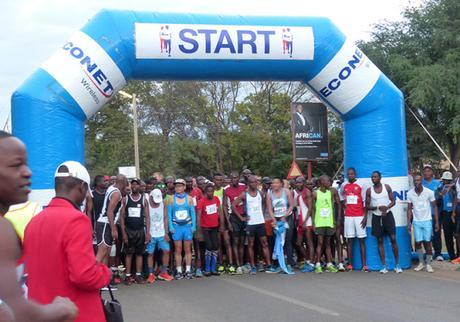
See that one white head sticking up above the crowd in back?
Legends of the Falls (Start–mile 14)
Start time arrived with little fanfare and no national anthem. With a final countdown we were off and headed directly toward the border and the town’s breathtaking namesake.
Crossing the bridge from Zimbabwe into Zambia on this initial out-and-back, it struck me that this would be my first truly international marathon, i.e. a marathon run in more than one country. Whereas many races include the word “international” in their name, most mean it in the sense of hosting runners from around the world, rather than in the literal sense of crossing borders. So this would be the first time I’d set foot in two countries over the course of a race.
(Back home both the Detroit Free Press/Chemical Bank Marathon and the Niagara Falls International Marathon—coincidentally run on the same day in October this year—cross the U.S./Canadian border, with the NFIM starting in the U.S. and finishing in Canada.)
Admittedly, the only real disappointment of the Victoria Falls Marathon is that you can’t see Victoria Falls from the course. This is unavoidable, however, and not the fault of the organizers, since as a World Heritage Site and the primary source of revenue for the town, the main Falls are hidden from view and so not readily visible from the road. Nonetheless, as though flexing its muscle for its guests, the Falls greeted us with a gentle mist as we crossed the bridge and approached the border post into Zambia.
From the bridge the Zambezi River, which separates Zimbabwe and Zambia, could be seen swirling far below. The spray from the Falls hung tantalizingly in the air, hinting at the raw power just out of view around the bend. Scenery-wise, this out-and-back segment between nations would be the highlight of the day.

The Zambezi River and “Boiling Pot” seen from the Zambezi Bridge
Traveler’s Tip: If you plan to visit Victoria Falls, your best bet is to purchase a KAZA UniVisa for $50 which allows much easier travel between Zimbabwe and Zambia, as well as day trips to Botswana (e.g. to visit Chobe National Park) through the Kazangula border. Katie and I each purchased a KAZA UniVisa upon arrival at the Zimbabwe airport. Entrance to the Falls themselves will cost you $30 on the (more developed) Zimbabwe side and $20 on the Zambia side. Both are worth the price of admission, particularly in the late fall/early winter (April–June) when water levels are at their peak. Later in the year when water levels fall, I’d stick to the Zimbabwe side. No matter when you go, be prepared (outside the park) to be approached by determined “artists” looking to sell you copper bracelets, wooden knick-knacks and other souvenirs.
No sooner had we crossed the bridge than we reached the turnaround point (manned by armed guards) and headed back the way we’d come, our total distance run in Zambia amounting to barely one of the race’s 42 km. As memorable as this border crossing had been, clearly the folks in charge needed us off the bridge quickly so they could reopen it to traffic.
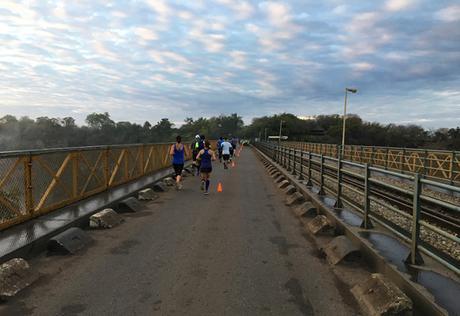
Crossing the Zambezi Bridge, mile 2
Good news greeted me along this first out-and-back—a lingering pain in the soft tissue on the top of my foot, an acute bruising sensation which had arisen after Comrades and which had flared up sporadically in the interventing two weeks (including this morning), subsided early in the race. Oddly— though maybe not so oddly if you’re a runner who understands the niggling aches and pains that come and go—that would be the last I’d hear from the top of my foot. It’s almost as if it had simply—missed running?
With the most scenic stretch behind us, the next 35 km would essentially amount to two loops through the more rural sections of town. Here the terrain remained fairly consistent: a variably dusty two-lane asphalt road with transitional stretches of dirt and sand. The morning remained pleasantly cool as the winter sun rose overhead, and with abundant cloud cover to thwart its rays, I wouldn’t have to don my sunglasses until around mile 7.
Traveler’s Tip: If you’re planning to run the Victoria Falls Marathon (assuming it’s still in June or July when you read this), bring your sunscreen but feel free to leave the mosquito repellent at home. Despite packing two types of repellent we failed to see a single mosquito during our stay in Africa, including 3+ days on safari plus another few days visiting one of the continent’s largest sources of water. Truth is, winter isn’t the mosquito’s breeding season. And while most travel guides will tell you the risk for malaria during the winter months (June–Sept) is low, based on our own experience in South Africa, Zimbabwe and Botswana, it’s effectively zero.
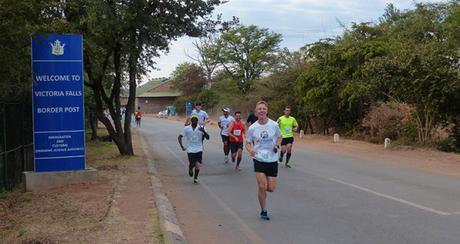
The best thing about the two out-and-back sections in the first half of the race was having the chance to see the lead pack pass in the opposite direction. Unfortunately, by the second half the leaders were too far ahead for me to catch a glimpse on the out-and-back.
Long stretches of open road were punctuated by the occasional tourist lodge, nature sanctuary or crocodile farm. One property advertised vulture feedings at 10:30am. The out-and-back section from miles 5.5–10.5 (and likewise miles 17–22) bordered Zambezi National Park, and though on this day the only wildlife along this stretch would be the huffing and puffing two-legged variety, the occasional armed guard stationed along the course testified to Nature’s presence and power in the region.
As uneasy as it made me feel to imagine a majestic animal being shot so I could run a marathon, at the same time I recognized this as a fact of life here in Zimbabwe, where wild and tame coexist in such close proximity. And maybe this is simply me rationalizing, but I got the strong sense that the rifles brandished by the guards would be used only as a (very) last resort.
The most extended uphill of the day (which again, we’d tackle twice) began at the tail end of this 5-mile out-and-back stretch. A steady, nondescript climb roughly two miles in length, I was relieved to encounter it for the first time early in the day, while the clouds persisted and the sun was not yet high in the sky.
We wouldn’t be so lucky on the second loop.
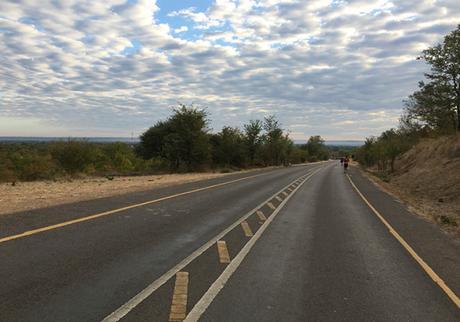
Climbing in mile 6 (and 17)
Starting at the hour mark, I downed a GU or Stinger gel—I find the latter easier to swallow on the run—every five miles or so, enough to provide the occasional burst of energy without upsetting my stomach in the rising heat. Like Comrades the aid stations offered water sachets (pouches) rather than cups, and after 87 km of practice in South Africa my teeth were sharpened and ready.
As originally devised, our travel plan had been to spend the duration of our African visit in South Africa. We’d added Victoria Falls only after a native Zimbabwean had mentioned it in passing at the Santa Barbara Wine Country Half Marathon expo in May. Somehow the conversation had turned to Comrades and he’d recommended that, while in Africa, we also check out the Victoria Falls Marathon that same month. Once planted, that seed had quickly germinated in the well-tilled soil of our brains—who knew when we’d have another chance to visit?—and within two weeks we’d changed our plans to include Victoria Falls.
This was, of course, before I had 87 km in my legs. A second marathon in Africa had seemed so carpe diem at the time. And if I’m being honest, Vic Falls offered an enticing backup for my African marathon, just in case Comrades didn’t go according to plan.
Known to the indigenous Tonga people as Mosi-oa-Tunya or “The Smoke That Thunders,” Victoria Falls has been named one of the Seven Natural Wonders of the World and is a popular tourist destination. And though I feel like we experienced Zimbabwe in much the same way a foreigner visiting Las Vegas experiences the United States, the Falls is a national treasure and for good reason.
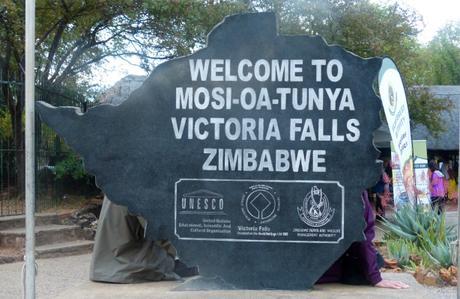
And speaking of national treasure, Zimbabwe needs all it can get because it’s clearly not a wealthy nation. The economy of Zimbabwe shrank dramatically at the turn of the century, resulting in widespread poverty and an unemployment rate as high as 95%. Hyperinflation led to the country suspending its own currency in 2009, and Zimbabwe paper money such as the 100-billion-dollar (as in $100,000,000,000) bill is now hawked around town as a souvenir.
Likewise, roving “artists” relentlessly peddle copper bracelets and wooden figurines in search of naïve tourists—and clearly a white man and Chinese woman look the part—willing to buy their wares at bargain prices. On our pre-race stroll across the bridge from Zimbabwe to Zambia and back, we were approached by a steady stream of self-proclaimed artists looking to chat us up about Obama or Trump while hoping to offer us a deal we couldn’t refuse.
Amazingly the same man—93-year-old Robert Mugabe—has ruled the country since first taking office in 1980 with the announcement that Rhodesia would be renamed as Zimbabwe. During his tenure he has been praised as a revolutionary hero by some and criticized as a corrupt dictator by others (sound familiar?); the truth, as with most complex characters, lies somewhere in the middle.
Quickie Quiz: Anyone know the capital city of Zimbabwe or the nation’s most widely spoken language?
A: Harare is the capital with a population of 1.5 million, while an estimated 70% of the population speaks Shona.

Miles 12–14 featured a gentle downhill that passed back through the blue start arch, signaling the start of the second loop. Here Katie awaited at the most convenient access point on the course. I waved, let her know I was feeling good, and switched gears again as the road turned back uphill over familiar ground.
Multi-loop courses aren’t my favorite—I always prefer a good point-to-point—and so with no new scenery to look forward to and no strict time goal to keep me dialed in mentally, I found my interest in running 26.2 miles flagging. I needed a distraction, some sort of pick-me-up to motivate me through the next 12+ miles.
Turns out “pick-me-up” was a poor choice of words. But as motivation goes, I may never top what happened next.
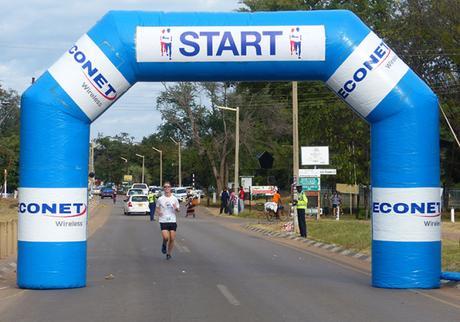
Back to the start, mile 14
Close encounters of the African kind (mile 15–finish)
I’d glanced up to my left at the billboard advertising an authentic African-themed dinner experience, when suddenly I heard the cracking of tree branches to my right. Instinctively I turned toward the sound and there, staring back at me and about to enter the road, was a solitary elephant. Not the largest elephant I’d seen in our travels, but as the heaviest land mammal on the planet, an African elephant of any size is large enough to ruin me.
And this was no zoo.
I slowed immediately, not wanting to startle him but not about to take my eyes off him either. He seemed to have the same idea. Luckily there were no other runners within 50 yards of us. I looked at him, he looked at me, we looked at each other. Then he let out a brusque snort, apparently surprised and not particularly amused to see a biped blocking his path. Why did the elephant cross the road? his steely eyes seemed to ask from beneath heavy gray eyelids. Get the hell out of my way and I’ll show you!
I could already picture the next day’s headline:
Darwin Award 2017: Slow-footed American startles unamused elephant
“I’d give 100 billion dollars to have him back,” says weepy spouse
During this exchange both time and I slowed to a crawl, though neither stopped. My brain, typically in standby mode during marathons, snagged momentarily—after all, we’d been instructed that the least attractive option when confronted with a pissed-off elephant was to run away. That said, I was already running away. And so I made the split-second decision to keep doing what I was doing and not break stride. I hoped this would have the dual benefit of a) not frightening him with any sudden movements and b) indicating by my retreat that I was no threat, and that I had no intention of thwarting his progress.
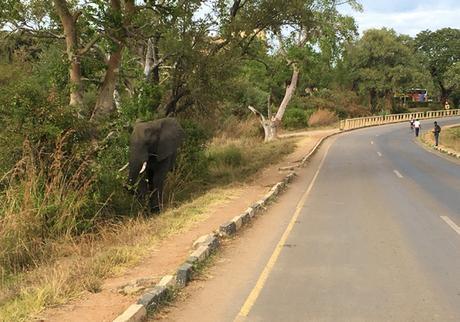
Best. Spectator. Ever.
And so I kept running as he remained still, eyeing me warily from the side of the road. As soon as I’d put roughly 20 yards between us (pretty sure I held my breath for the first ten), I quickly turned back and snapped a photo—‘cuz what good is getting trampled by an elephant while on vacation if no one believes you? All without spooking the animal or soiling myself.
I guess I just have a way with wildlife.
Then I picked up my pace and accelerated up the hill, toward a group of spectators and volunteers who were all staring down in my direction and pointing back the way I’d come.
Behind me I heard my new acquaintance trumpet loudly, presumably to let the other curious bipeds know that like it or not, he was damn well going to cross the road. His road.
(I note this unsettling incident which occurred one month after our visit to Vic Falls—a tragic and horrific story which starkly demonstrates the raw, unpredictable power of these animals. My heart goes out to the family of the unfortunate guide.)

Instructions posted at the pre-race expo
Predictably I rode a bit of an adrenaline surge for the next few minutes—so much so that despite having 14 miles in my legs, despite slowing for the elephant and despite stopping to capture a couple photos of baboons frolicking alongside the course and in the trees, I still managed my fastest and only sub-8:00 mile of the day in 7:53.
No wonder the world’s fastest runners hail from Africa.
The course was not closed to traffic and occasionally a car or truck would pass, flattening half-filled water sachets with a {POP} and stirring up dust in its wake. As the sun rose in the sky and the day grew hotter, a noseful of warm orange dust wasn’t exactly a refreshing surprise. But this was Zimbabwe after all and besides, if you’re planning to run a marathon and do it comfortably, you should probably find a different sport.
As the African sun burned away the remaining cloud cover, the déjà vu of our surroundings didn’t bother me as much as the mounting heat and steady diet of rolling hills. Whereas every uphill in the first half of the course seemed to have a corresponding downhill, the second half—like a life well lived—definitely had more ups than downs.
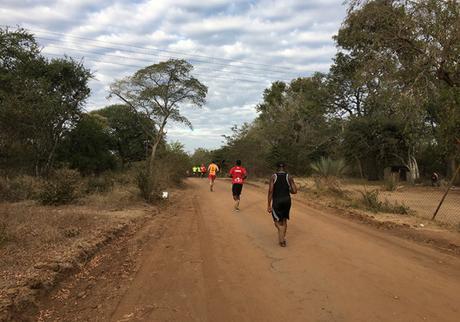
The turnaround point at mile 9 (and 20)
The highlight of the last out-and-back stretch (miles 17–22) was a group of small children watching from the side of the road, some quiet and others more enthusiastic. As I’d done at Comrades, I slowed and bent down to share high-fives with them as I passed. Their bright eyes and excited smiles lifted my spirits and were nearly as motivating as an anxious elephant.
“Thank you!” I responded reflexively over my shoulder and then, realizing they may not speak English, followed that quickly with a thumbs-up sign. The chorus of giggling behind me was more beautiful than the Falls themselves. Because laughter really is its own natural wonder of the world. And anywhere on the planet—no matter one’s nationality, ethnicity, skin color, language, socioeconomic status, shoe size or popsicle preference—a five-year-old is a five-year-old. No hatred, no judgment, no bottled-up feelings of rage or resentment at a world that doesn’t understand them and which they can’t control. Only wide-eyed joy, unconditional love and the giddy appreciation that comes with living each and every moment without regret and in a world of unlimited possibility.
Buoyed by these tiny spectators I pressed on, and was able to see new Bay Area friend Gloria pass in the opposite direction, looking tired but strong a few minutes ahead of me. Her husband Jihua remained some distance behind, though just how far I didn’t know.
Three times along the course an ambulance approached with siren wailing, and three times it blew past me without stopping. Dodged another one, I thought on each occasion.
By mile 22 I was struggling bigly, and it became abundantly clear that Comrades is the gift that keeps on giving. Two weeks of travel in a foreign land apparently hadn’t been enough to clear those 87 km from my legs.

Grazing wart hogs in dappled lighting, mile 22
I was momentarily distracted from my discomfort by a pack of wart hogs, which I inadvertently surprised as they stood grazing on a sun-dappled patch of green grass. The skittish animals retreated a short distance before realizing I was no threat and returning to their meal, while keeping a safe distance between us juuuuust to be sure.
Soon after the wart hog sighting I stopped briefly to shake out and stretch my overworked legs and hips. And soon after that, on another gradual climb with the sun directly ahead and beating me in the face, my cadence became so slow and labored that I was forced to slow to a hike along with two other runners. Reaching the top of the hill I continued to power-walk for a short distance, too exhausted to run immediately but refusing to concede a second more than was absolutely necessary.
This scenario repeated three or four more times, as each time the combination of heat and hills (no matter how gentle the grade) stopped me in my tracks, along with every other runner around me. By this point there were very few runners around me who were still, well, running. As it turns out, seeing other runners walking is itself tiring, and has the psychological effect of making it harder to pick up the pace yourself. At the same time, I’m pleased to report that only one runner passed me the entire second half of the race, and that happened in the final km.
At the next aid station I grabbed an orange slice, sucking out the juice like I’d discovered the elixir of life. One orange at a time, one mile at a time, one step at a time.

The number of aid stations—and the number of volunteers manning those aid stations—seemed to shrink in the later miles. As it had in the heat at Comrades, water again grew unappealing late in the race, a bizarre notion considering the human body is roughly 60% water. Which tells you just how stressful running 26.2 miles in the heat can be.
It didn’t help that the water here was less consistently cold than it had been at Comrades.
By mile 24 I had no idea whether a sub-4-hour finish was still within reach, but if so it was quickly slipping away. After two straight 11+ minute miles, how many more could I log and still have a shot at sub-4? To be honest, though, this wasn’t my primary concern as everything now felt like it was working against me: the heat, the hills, the final 10K of a marathon, the many hours spent on foot the day before viewing the Falls from both the Zimbabwe and Zambia sides. And of course there was the little issue of the 87 km I’d run two weeks earlier…
No, at this point I needed to focus all my energy on simply finishing this race while enjoying the final two miles of my Africa experience as much as possible. Easy to say when you’re sitting at home writing a blog post, tougher to do in the moment when you’re suffering mightily.
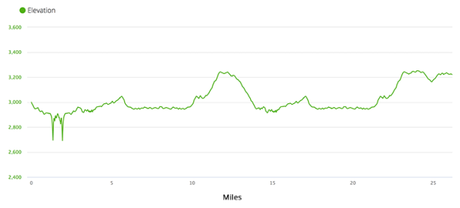
Those two sharp downward spikes are Garmin error on the bridge
Just after the 40km marker I caught up to a fellow wearing a familiar cap. “Looking good, Comrades runner!” I encouraged him as I passed, to which he responded, “Man, this is killing me!” Clearly the Ultimate Human Race was still extracting its pound of flesh from us all.
The “2 KM TO THE FINISH —>” sign was followed by a sharp right turn and more consternation at seeing the road ahead of us leading uphill yet again. I’d been hoping we might finish the second half of the race the same way we’d closed out the first, with a speedy descent that carried us through the finish line.
On the contrary, there would be no more downhills, no more joyful children, no more snorting elephants to keep me motivated and moving, only raw will and determination to get… this… thing… done.
The density of runners increased as the marathon and half marathon courses merged one last time. Everyone seemed to be moving in slow motion now, and essentially they were—these remaining half marathoners were now approaching the 3½ hour mark, so they were in no hurry to reach the finish.
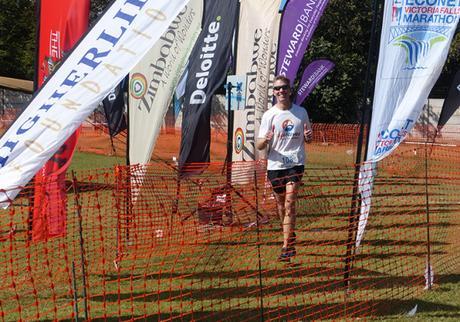
Entering the finish chute
One final right turn led us onto the grounds of the Victoria Falls Primary School where finishers and spectators milled about as race officials tried to prevent them from strolling into the path of oncoming runners. My sole focus now was on finding the finish line, and I used the last of my energy reserves to weave around these folks and onto the grass track where I saw the blue finish arch—nowhere.
Where was that fucking arch?
Clearly it was close—I heard the music blasting and saw the crowds of happy finishers celebrating on the grass as I circled the cricket field slowly, like a hungry but exhausted shark. Glancing back I saw the finish arch at last, positioned at the end of a spiral path leading me back the way I’d just come. This was definitely the 0.2 of the 26.2 miles and an appropriately sadistic finish to an unforgettable challenge.
The sponsor flags seemed to salute me as I passed, the finish chute feeling like a red carpet as I dragged my spent body across the line. As relieved as I was to be done, I was equally ecstatic at what came next. Glancing down at my Garmin I saw an unofficial finish time of 3:58:19 staring back at me (official time 3:58:12). Somehow I’d done it—I’d kept my streak of sub-4 road marathons intact, in the process accomplishing my one and only real goal of the day.
And I have an agitated pachyderm to thank for it.
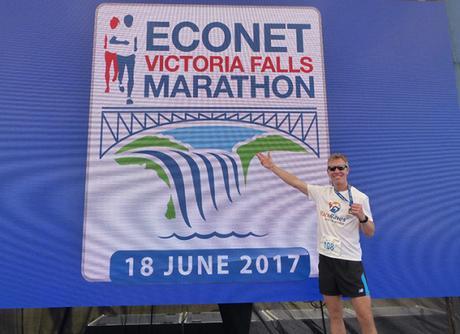
Out of Africa
With my second African finish in the books I gratefully accepted my finisher’s medal and tanktop, both still in their protective plastic bags. And maybe it’s just me, but being handed a medal that’s still in its baggie after running 26.2 miles is always a letdown—I much prefer the pomp and circumstance of having a volunteer hang it around my neck, or at least hand it to me by the ribbon so it feels more like an award than an afterthought.
At that moment I never wanted to run again—I was S-P-E-N-T. Not quite vomit-in-the-bushes, I-may-never-get-comfortable-again spent like at Comrades, but spent enough that the thought of running another step left me woozy. I threw my arms around Katie (as much for support as in celebration) and staggered toward a shaded tent. There I collapsed in a chair and, like a newborn wearing mittens, worked haplessly to open a pouch of chocolate milk. As usual, my post-race stomach wanted only to be left alone.
Exhilaration and body odor filled the air, the winter sun continuing its assault on the packed cricket field. Moments later I heard my name announced over the PA, presumably a delayed congrats for having finished a tough but gratifying race.

The music played on as the announcer continued to congratulate finishers, including one fun run finisher who was greeted with “Congrats on taking so long to join us!” The field was a sea of red and blue, and it was cool to see so many happy finishers all sporting their race apparel in unison. The mayor of Victoria Falls said a few scripted words, a representative from Econet (the title sponsor) reinforced the company’s commitment to the marathon as it continues to grow, and our new friend Gloria accepted her award for finishing in tenth place among female finishers. Then we hobbled out to the dirt parking lot where, after some confusion, we succeeded in flagging down a shuttle to transport us back to the Kingdom Hotel where a lazy afternoon awaited.
And with that it was time to bid Zimbabwe and Africa farewell, but not before we promised to meet again soon. We’d only scratched the surface of what this vast and amazing continent has to offer.
Victoria Falls may not be the largest, or the sexiest, or the most hyped marathon in Africa. But unlike many American marathons, it continues to grow each year and for good reason. No other race on the planet promises immediate proximity to one of the Seven Natural Wonders of the World and a potential close encounter of the two-tusked kind. If you’re a Seven Continents hopeful or a traveling runner of any kind, I’d recommend you take a good long look at Vic Falls when planning your African adventure.
And if not? Well tusk, tusk on you.
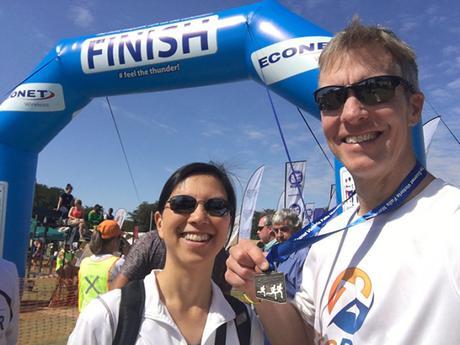
Traveler’s Tip: If you have a choice, do yourself a favor and avoid intercontinental travel the day after a marathon. Your immune system will already be compromised from the effort, and the physical toll exacted by the race + many hours of cramped quarters and recycled air = an illness waiting to happen. Case in point, fellow SoCal runner Gil ended up in bed for two days with a nasty flu after flying back the day after his impressive 8:40:02 finish at Comrades. And though I was lucky to avoid the same fate, flying from Zimbabwe to Los Angeles the day after the Vic Falls Marathon wasn’t an experience I’d be eager to share.
BOTTOM LINE: Victoria Falls may not be the largest, or the sexiest, or the most hyped marathon in Africa. But unlike many American marathons, it continues to grow each year and for good reason. No other race on the planet promises immediate proximity to one of the Seven Natural Wonders of the World and a potential close encounter of the two-tusked kind. If you’re a Seven Continents hopeful or a traveling runner of any kind, I’d recommend you take a good long look at Vic Falls when planning your African adventure.
Other than the initial out-and-back across the bridge alongside the Falls, you won’t have the benefit of head-turning landscapes. The dusty two-loop course lacks compelling scenery, a fact made more conspicuous by having to run it twice. And even in winter, you should plan for a warm day—you can always be pleasantly surprised if cooler temperatures prevail. This is Africa, after all.
And yes, an African elephant (the largest land mammal on the planet) did wander onto the course next to me in mile 14, an encounter that seemed to surprise us both. I’m proud to say I managed to give him clearance and still snap a photo, all without spooking him or soiling myself.
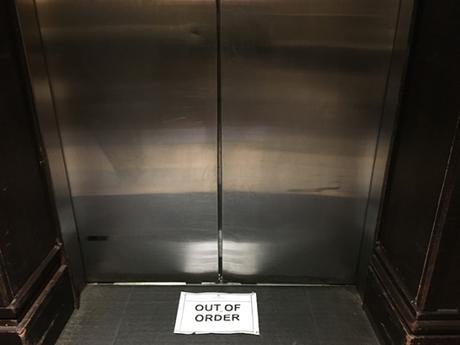
Not the sign you want to see on your 3rd floor elevator after a marathon
PRODUCTION: The organizers do a first-class job of hosting their third-world marathon. The Kingdom Hotel where we and many other runners stayed is a 3-minute walk from the start line, always a huge advantage. Likewise the outdoor expo held at the Kingdom Hotel was pleasantly small and easily navigated. At the expo we were able to sign up for shuttle service from the finish line back to the hotel on race day. And though shuttle service at the finish line at Vic Falls Primary School was a bit disorganized, the brief inconvenience was nothing that a bit of patience didn’t resolve.
The course could have used another aid station or two in the closing miles, and maybe a few more buckets of ice in which to store the water sachets. And there weren’t a whole lot of spectators, but then again that’s not really the expectation in a tourist town like Victoria Falls. Besides, I’m pretty sure my ears were still ringing from all the cheering at Comrades, so a low-key but well-supported race was just what this doctor ordered.

The pre-race expo at the Kingdom Hotel
The course wasn’t closed to traffic, but on sparsely traveled two-lane roads this was never a concern, aside from the clouds of dust kicked up by passing vehicles. Though seeing discarded water sachets being blown into the underbrush by passing trucks was disheartening, and I hope the organizers and volunteers were able to find and collect them before the wildlife did.
SWAG: First time ever I received a finisher’s tanktop (rather than t-shirt), and an attractive one it is—eye-catching red and blue with the race logo emblazoned on front. And it was cool to see everyone wearing theirs at the finish line festival. I’m not a huge “suns out, guns out” guy with my runner’s physique, but I’m sure I’ll find ample use for it in the SoCal heat. The finisher’s medal is also nice, though small and understated, and depicts three (male?) runners with the Falls in the background. And despite its diminutive size, it’s still the largest of my African medals!
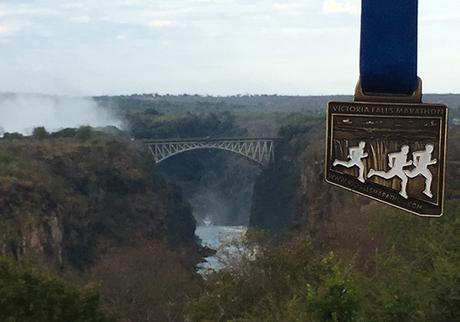
RaceRaves rating:
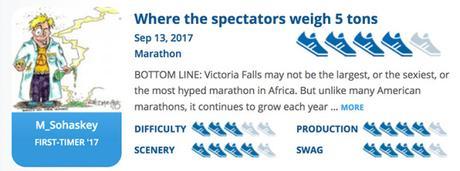
FINAL STATS:
June 18, 2017 (start time 6:45am)
26.19 miles in Victoria Falls, Zimbabwe
Finish time & pace: 3:58:12 (first time running the Victoria Falls Marathon), 9:06 min/mile
Finish place: 92 overall, 26/60 in the “Veteran” category
Number of finishers: 276 (201 men, 75 women)
Race weather: cool & cloudy at the start (temp 59°F), warm & sunny at the finish (mid-70s)
Elevation change (Garmin Connect): 1,421 ft ascent, 1,194 ft descent
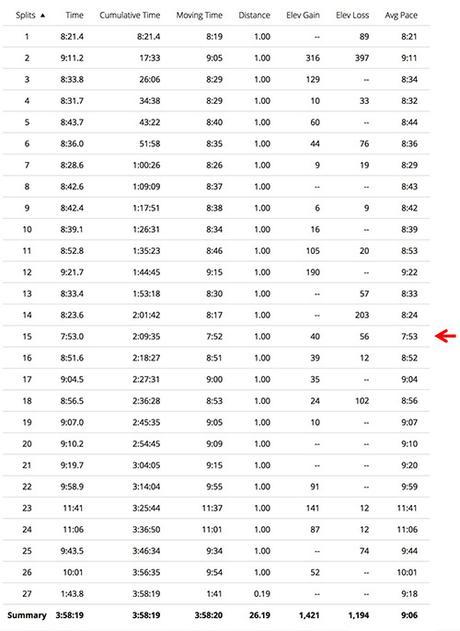
Red arrow indicates my elephant encounter and fastest mile
Advertisements